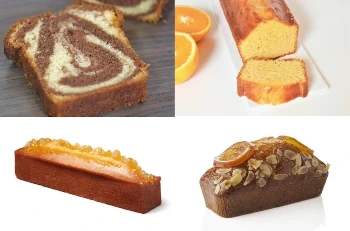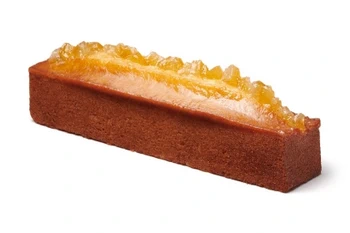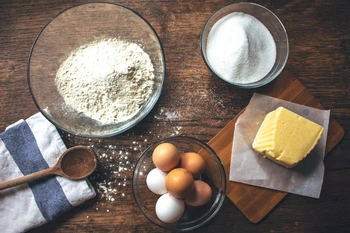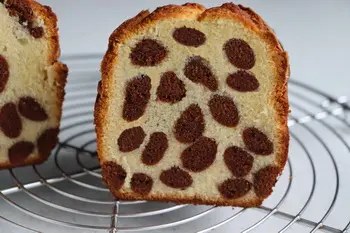This site uses only a few technical cookies necessary for its operation. By continuing to browse, you accept their use.
To find out more...
To find out more...
Travel cakes

You may have come across the term "travel cakes" ("gateaux de voyage" in french) for certain pastries, so let's take a look at what they're all about.
7,097
Keywords for this post:PastryLexiconCakesTravelExplanationsLast modified on: January 27th 2025
Travel cakes
Where does the name come from?
Historically, these cakes were made to accompany long journeys, often by boat, train or stagecoach. The aim was to create a cake that was not fragile, that could withstand a little shaking, and that kept well, at least for several days, and didn't need to be put in the fridge.
Characteristics of a travel cake :

To meet all these requirements, travel cakes have certain compositional imperatives:
- They contain no cream (in the sense of crème pâtissière or chantilly, for example), nor fresh fruit, which would not last the desired several days.
- They often have a dense or fluffy texture that enables them to remain pleasant without drying out quickly.
- They generally contain a low water content to limit the risk of mold and extend their shelf life.
- They are often simple in shape, typically cake-shaped, rectangular and elongated.
Classic ingredients:

Travel cake recipes are generally quite simple, using classic ingredients:
- butter, sugar, eggs, flour
- Sometimes enriched with dried fruit (almonds, hazelnuts, pistachios), candied fruit or spices.
- Some recipes include alcohol, such as rum or Grand Marnier, for added flavor and preservation.
Some examples of travel cakes:

- All cakes: chestnut, clementine, chocolate, hazelnut and orange, ...
- Roasted almond cake
- Oatmeal walnut cake
- Leopard cake
- Gingerbread
- And many more...
In a nutshell: "Gâteau de voyage" is a lovely French gastronomic term, referring to long-lasting, easy-to-carry cakes that you can take with you on a trip.
Lasts posts
Butter vs. grease
We often read in a recipe where a pastry is put into a mould that, just before pouring, the mould should be buttered or greased. But what's the difference between these 2 terms?December 1st 20251,2075
Getting out of the fridge early
Very often when you're cooking, you need to take food or preparations out of the fridge, to use them in the recipe in progress. There's nothing tricky about this: you just take them out of the fridge and use them, usually immediately, in the recipe. But is this really a good method?November 24th 20251,2105
Who's making the croissants?
When you look at a bakery from the outside, you naturally think that in the bakery, the bakers make the bread, and in the laboratory, the pastry chefs make the cakes. It's very often like that, with each of these professions having quite different ways of working, but sometimes there's also one...November 23th 20251,104
Oven height
When we put a dish or cake in the oven, we naturally tend to put it on the middle shelf, and that's what we usually do. But in some cases, this position and height can be a little tricky, so let's find out why.October 8th 20253,0005
The importance of sieving
In recipes that use a fine powder (flour, powdered sugar, etc.), you'll often see the advice to sift before using it. To sift is to pass the powder in question through a sieve (a very fine strainer) before incorporating it into your recipe. It's often advice, but is it really useful?September 3rd 20257,7053
Other pages you may also like
What is the difference between bakery and patisserie?
This is a question that you may well have asked yourself and which I will attempt to answer. In France the two trades of "boulangerie" (bakery) and "pâtisserie" (patisserie and confectionery) have always been quite distinct, but where exactly do the boundaries lie? .February 7th 2017134 K 14.1
The golden-brown finish on puff pastry
Let's take a look at the tricky matter of producing puff pastry with an attractive, golden-brown finish. French pastry chefs call this "dorure" (literally, "gilding"). Behind this quirky term there lurks a real problem (and the solution): when using puff pastry (pâte feuilletée) for a pie, or...February 8th 201847 K 24.6
The super powers of cornstarch
I start this new year by evoking an old product, that you most probably have in your cupboards, a white powder, often in a small cardboard package with a slightly outdated look, only the "gluten free" is relatively recent, it is simply cornstarch, hence its name of maïzena. It's used for a lot...January 14th 202215 K
Unmoulding cakes while hot
When you make a cake, pound cake or whatever (what bakers call a "travel cake" because it's easy to carry around) you've most likely made a batter, either by hand or in a food processor, which you then pour into a buttered pan. It's a classic, and I've already talked to you about 2 or 3 tips on...February 6th 202139 K4.6
Candied fruits: don't get ripped off
Do you like candied fruit? You might like to nibble a handful or add it to a recipe, like a classic fruit cake or delicious Italian specialities like panettone or sicilian epiphany pie.June 21th 201767 K 24.2
Post a comment or question
Follow this page
If you are interested in this page, you can "follow" it, by entering your email address here. You will then receive a notification immediately each time the page is modified or a new comment is added. Please note that you will need to confirm this following.
Note: We'll never share your e-mail address with anyone else.
Alternatively: you can subscribe to the mailing list of cooling-ez.com , you will receive a e-mail for each new recipe published on the site.









